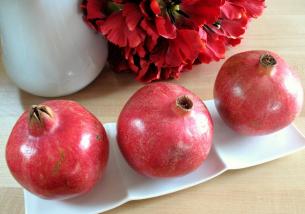
What are pomegranates?
These round, pinkish-red fruits are native to Iran and India. In season from around September to January, pomegranate are chock-full of sweet-tart-tangy seeds that can be eaten out of hand or used to top salads and other dishes.

The seeds are called arils. They’re like little bubbles of juice that burst in your mouth, and have a crunchy center. The arils contain Vitamin C and high levels of antioxidants – even more so than blueberries or red wine. But it takes a bit of work to get at them: they’re tightly packed among sections of white membrane that is quite bitter.
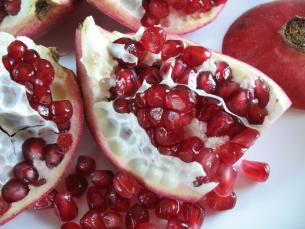
Separating them from the inedible membrane typically causes some of the arils to break and spurt juice, so it’s good to know how to open pomegranates properly.
How to open a pomegranate
Keep in mind that pomegranate juice can stain fabric, certain types of counters and wood cutting boards. It’s not a bad idea to wear an apron when cutting a pomegranate, and use a plastic cutting board, being careful that you don’t drip juice on the counter.
According to the California-based Pomegranate Council, the best way to open a pomegranate is to cut off the crown…
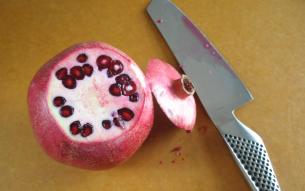
…then score the pomegranate into four sections.

Break the pomegranate in half by gently pulling it apart with your fingers.
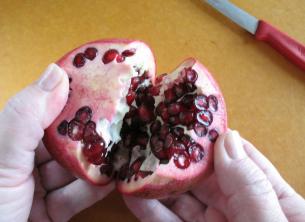
Then break the half into quarters.
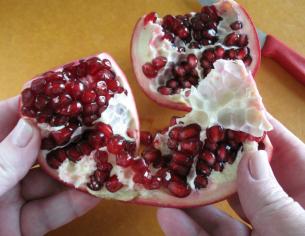
Now place the sections in a bowl of cold water…
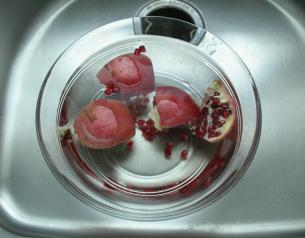
…and roll the arils (seeds) out of the membrane with your fingers, letting them sink to the bottom of the bowl.
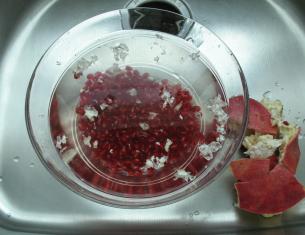
Doing this in the sink, under water, prevents the seeds from spurting all over you and your kitchen!
Discard the empty membranes and pick out the bits that are floating on the top of the bowl. Then turn the bowl of water over a strainer…
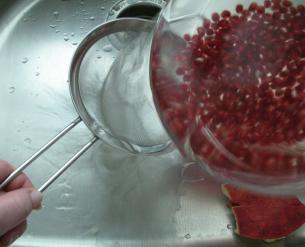
…leaving just the pomegranate seeds.
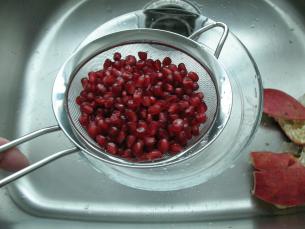
They’re ready to eat!
I do like to spread them out on a paper towel to air-dry before adding them to a recipe or freezing them.
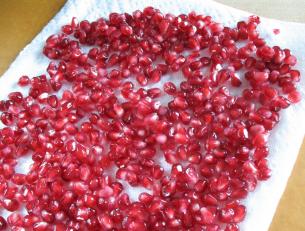
An average pomegranate weighs about 9 ounces, the edible seeds weigh about 5 1/2 ounces which will yield about one cup of seeds.
Vinegar or lemon juice will help remove juice stains from a cutting board.
If you would like to make pomegranate juice, simply put the arils in a blender…
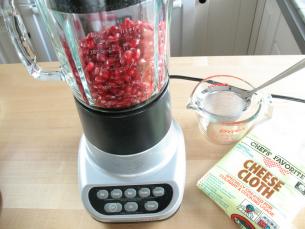
…and pulse until liquefied.
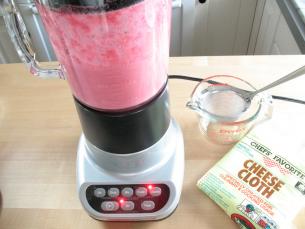
For a nice silky smooth juice, be sure to press the liquefied seeds through a strainer or some cheesecloth. (Cheesecloth is a long, lightweight, cotton cloth that has a multitude of kitchen uses including straining liquids and forming packets for herbs and spices. It is sold in kitchen shops and at the grocery store.)

Discard the pulp and enjoy some fresh pomegranate juice!
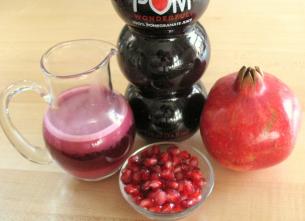
(Note: once the air deflates out of the juice from all that blending, it does turn from a pinkish color to the deep red color similar to the store bought juice.)
Buying and storing
Because pomegranates are only picked when ripe, you don’t have to wonder whether they’re ripe when you buy them. Pomegranates have a tough, leathery skin that ranges from pink to red in color. Look for ones that are heavy and don’t have split or cracked skin. At room temperature, they last several days; in the fridge, they’ll last up to three months. Pomegranate seeds can be frozen: spread them on a try or baking sheet in a single layer, then store in plastic bags for several months. (Do not defrost them under warm running water or they will loose all their flavor!)

How to use pomegranate
- Pomegranate seeds can be sprinkled on fruit salad, yogurt, ice cream, and other desserts for colour, flavor and texture. Pomegranate also gives a refreshing crunch to all kinds of savory dishes, like salads, soups and rice dishes.
- Here’s a recipe for Barley and Wild Rice Pilaf with Pomegranate. It’s hard to find a healthier combination of ingredients than this!
- From the POMWonderful website, a recipe for Pomegranate salsa.
- These grilled lamb chops call for a cup of pomegranate juice.
- For the holidays, try mixing pomegranate into your cranberry sauce.
If you are new to startcooking, or are a regular visitor here, please consider subscribing for free.








































KGWagner said:
Funny you should bring these fruits up now – I never had one of these things until just a couple weeks ago. Got a couple on a whim, just to see what they were like. Made a salad dressing with them. It was um… different. Used a strainer to clean the juice, but should have used a cheesecloth.